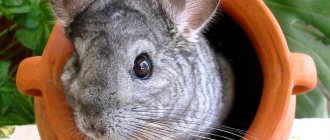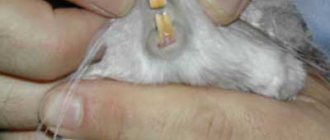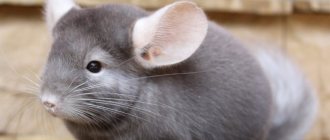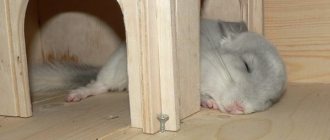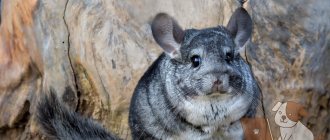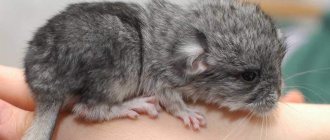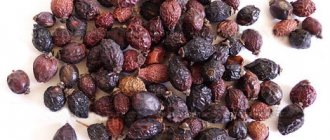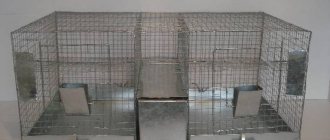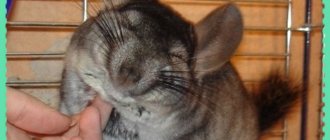- Wild animals
- >>
- Mammals
For many, such an interesting animal as the chinchilla is not at all a rarity; it has long become a common pet. This is no wonder, because these cute fluffy rodents are very attractive and cute. But chinchillas living in the wild are not easy to meet, because there are very few of these animals left, and they live only on one South American continent.
Origin of the species and description
Photo: Chinchilla
It is still unknown who the ancestor of the chinchilla is. Carrying out archaeological excavations in the Cordillera, scientists extracted from the bowels of the earth prehistoric fossils, which in their structure are very similar to chinchillas, only much larger in size. This animal, according to experts, lived forty thousand years ago, so the chinchilla genus is quite ancient. The Incas, many centuries ago, depicted chinchillas on rocks; this painting has survived to this day.
The Incas made various items of clothing from the soft skins of chinchillas, but among the Indians they were far from the first who were so attracted to the fur of rodents. The first who began to wear clothes made from chinchilla skins were the Indians from the Chyncha tribe. It is believed that the chinchilla got its name from them, because the word “chinchilla” itself is consonant with the name of an Indian tribe.
Video: Chinchilla
For the Incas, the value of chinchilla fur was very high; they maintained constant control over their production so as not to harm the animal population. But by the end of the 15th century the situation got out of control, because... The Spaniards who arrived on the mainland began a ruthless hunt for helpless rodents, which led to a rapid decrease in their numbers. The authorities of such South American countries as Chile, Bolivia and Argentina have banned the shooting of animals and their export, and introduced severe punishment for illegal hunting.
The chinchilla is a rodent from the chinchilla family of the same name.
These animals have two varieties:
- short-tailed chinchillas (coastal);
- Chinchillas are large, long-tailed (mountain).
Mountain chinchillas live at high altitudes (more than 2 km), their fur is thicker. This species is distinguished by a hump nose, which is designed for inhaling chilly mountain air. The coastal type of chinchillas is much smaller, but the tail and ears are much longer than those of mountain chinchillas. Officially, the short-tailed chinchilla species is believed to have disappeared completely, although local residents say they have been seen in remote mountainous areas of Argentina and Chile.
It is interesting that the first chinchilla farm was organized by the American Mathias Chapman, who brought the animals to the USA. He began to successfully breed chinchillas in order to sell their valuable fur; many then followed in his footsteps, organizing their own farms.
What to feed your chinchilla?
Chinchillas are vegetarians, so when choosing food, you should take this feature of the animal into account. The chinchilla needs to be fed with special food. Pet stores have a huge range of granulated food. This food contains essential vitamins and minerals.
In addition to food, you must feed your chinchilla hay. You can prepare it yourself; for this you need to collect clover, dandelions and herbs. But you can also buy hay at a pet store. When purchasing, pay attention to the quality of the hay; it should be dry, clean, free of unpleasant odor and mold. A special hay feeder should be placed in the cage.
The chinchilla should be fed once a day. Food and water should always be fresh. Water should be given filtered or boiled. There should always be a special stone in the cage for grinding teeth, which can be purchased at any pet store.
Pelleted dry food and hay are the best diets for chinchillas. As a top dressing, you can give your chinchilla flax seeds, corn grains, dandelion leaves, birch, willow, raspberry, apple, currant and linden branches. But under no circumstances give branches of cherry, oak and coniferous trees. You should not feed your chinchilla many fresh vegetables and fruits, as this can lead to stomach problems.
Chinchillas especially love raisins, dried apricots, dried apples, pears, cherries and rose hips. But such treats should not be given often. Also be careful with nuts and seeds, they should be given in very limited quantities and only raw; fried grains are contraindicated for the animal. You should not give your chinchilla food from your own table (bread, cookies, etc.).
Appearance and features
Photo: Long-tailed chinchilla
Long-tailed chinchillas are very small, their body grows no more than 38 cm in length. The length of the tail varies from 10 to 18 cm. Long rounded ears reach 6 cm in height. Compared to the body, the head is quite large, the muzzle is round with cute large black eyes, the pupils of which are located vertically. The animal's whiskers (vibrissae) are long, reaching up to 10 cm; they are necessary for orientation in the dark. The weight of an adult rodent is less than a kilogram (700 – 800 g), the female is larger than the male.
The fur coat of the animals is pleasant, fluffy, soft, with the exception of the tail, which is covered with bristly hairs. The color of the fur is usually gray-blue (ashy), the belly is light milky in color. Other colors can be found, but they are rare.
A chinchilla has only 20 teeth, 16 of them are molars (they continue to grow throughout life). Compared to other numerous rodents, chinchillas can be called long-livers; these cute animals live up to 19 years. The chinchilla's paws are small, the animal has 5 fingers on the front limbs, and four on the hind limbs, but they are much longer. Pushing off with their hind legs, chinchillas perform long, deft jumps. The coordination of the animal can be envied; possessing a highly developed cerebellum, the chinchilla skillfully conquers rocky massifs.
An interesting biological feature of the rodent is its skeleton, which is capable of changing its shape (shrinking) if the situation requires it. At the slightest threat, a chinchilla will easily slip into even a tiny crevice. Also, one of the unique features is that the animal does not have sweat glands, so it does not emit any odor at all.
Description of chinchilla
The chinchilla looks very cute and funny. The chinchilla animal has a large head, short neck and round body. She has large ears, a long mustache and a short tail. The chinchilla looks like a small rodent. Chinchillas range from 25 to 35 cm in length, with females being larger than males. The rodent weighs 500-700 grams.
The chinchilla looks fluffy, as if made of plush. She has soft, thick and beautiful fur. The chinchilla looks inconspicuous due to its gray-blue color and only on its belly its fur has a light gray tint. Modern colors of captive-bred chinchillas are varied and have many variations.
The description of the chinchilla includes many unusual facts about these rodents. For example, their ears have special membranes, with the help of which the animals close their ears during sand baths so that sand does not get inside. Chinchilla fur is very dense because up to 80 hairs grow from each hair follicle.
Thanks to the developed cerebellum, the chinchilla animal has good coordination and is adapted to night life. The animal's hind legs are longer than its front legs, which allows it to jump to a height of up to 2 meters. Chinchillas make many interesting sounds, they can quack, chirp, growl, squeak and click their teeth.
Where does the chinchilla live?
Photo: Animal chinchilla
As already mentioned, the only continent where chinchillas are permanently registered in the wild is South America, or more precisely, the Andes and Cordillera mountain ranges. Animals are distributed from Argentina to Venezuela. The highlands of the Andes are the element of chinchillas, where they climb to heights of up to 3 km.
Little fluffies live in rather harsh, spartan conditions, where cold winds rage almost all year round; in the summer, the daytime temperature does not exceed 23 degrees plus, and winter frosts drop to -35. Rainfall in this area is very rare, so chinchillas avoid water procedures; they are completely contraindicated for them. After all, once wet, the animal will be chilled to the very bones. Rodents prefer to clean their coats by bathing in sand.
Typically, a chinchilla makes its lair in all sorts of small caves, rocky crevices, and between stones. Occasionally they dig holes in order to hide from various predatory ill-wishers. More often, chinchillas occupy abandoned burrows of other animals to live. In the wild, it is possible to meet a chinchilla with your own eyes only in Chile. In other countries there are so few of them that it is not possible to see rodents. And in Chile their population is under threat.
Chinchilla diseases
Chinchilla diseases are most often the result of improper care and poor nutrition. The most common problems are: gastrointestinal upset (usually due to low-quality or expired food, poor feeding habits or a monotonous diet), hair problems (the cause may be a lack of vitamins or skin parasites), obesity, bladder stones, conjunctivitis, periodontal disease , sunstroke or hypothermia.
If you have the slightest suspicion that your chinchilla has health problems, you should contact your veterinarian. It is extremely undesirable to delay visiting a doctor, because the sooner the problem is identified, the greater the chance of curing your pet.
Take care of your pets, take care of them and do not forget that we are responsible for those we have tamed. If you liked this article, subscribe to site updates to be the first to receive the most interesting and useful articles about animals.
Don't forget to share with your friends!
What does a chinchilla eat?
Photo: Chinchilla animal
The chinchilla's preference is plant food, which in the Andes mountains is quite scarce and monotonous.
The main rodent menu includes:
- herbs;
- small bush growth;
- cactus plants (succulents);
- mosses and lichens.
Animals receive moisture from dew and cactus plants, which are very juicy and fleshy. Chinchillas can eat the bark, rhizomes of plants, their berries, and do not disdain various insects. At home, the chinchilla menu is much more varied and tastier. People buy special grain feeds at pet stores. Animals love to eat not only fresh grass, but also various fruits, berries, and vegetables. Chinchillas will not refuse a crust of bread, dried fruits and nuts. Rodents eat hay in large quantities. The diet of chinchillas is very similar to the diet of hares or guinea pigs.
Under natural conditions, chinchillas do not experience any special problems with the intestines and stomach. Although they eat a large amount of green vegetation, some contain a lot of tannins, which help food to be digested normally. Scientists have noticed that in the mountains, next to chinchillas, chinchilla rats live, which make storage rooms with food in their burrows. Chinchillas also constantly use these reserves, eating the food of their prudent and thrifty neighbors.
Interesting Facts
Due to their small numbers and living in high mountain areas, chinchillas have not been studied as well as we would like. However, several interesting facts about these mysterious animals are still known. For example:
- The chinchilla body does not synthesize the enzyme that breaks down sucrose into simpler carbohydrates - glucose and fructose. Therefore, sweet and starchy foods are considered harmful to them.
- Female chinchillas have poorly developed parental behavior. They may leave the nest frequently and feed their young with milk for only 6-8 weeks. At the same time, until the new mother’s lactation normalizes, she does not try to feed the puppies at all. They literally run after her, trying to grab the nipple. Sometimes, in competition for mother's milk, stronger cubs kill weaker ones. Also, the chinchilla, unlike most other mammals, never drags its puppies to warmer and more protected conditions.
- In natural conditions, chinchillas never suffer from indigestion. The thing is that the alpine plants that fluffies eat contain astringents that strengthen the stool.
- Chinchillas are very hardy animals with good health. It has now been established that a healthy adult chinchilla can survive without food and water for 6-7 days. In this case, the animal will not lose weight and will not suffer complications from internal organs.
- Chinchillas are one of the few animals that do not shed seasonally. Also, their fur is hypoallergenic, and due to its high density, skin and blood-sucking parasites cannot live in it. Therefore, fluffies are ideal pets for allergy sufferers. However, sometimes chinchillas can still shed their fur - during stressful situations and when protecting themselves from enemies. The fluffy one easily throws off a clump of fur caught in the teeth of a predator and runs away for cover.
- In natural conditions, the chinchilla often uses one very original defensive reaction. If the animal has nowhere to hide from the enemy, it stands on its hind legs and, emitting a battle cry, literally bombards the predator with a powerful stream of urine.
Many owners of these cute animals have no idea where chinchillas live in the wild and know nothing about their range and habitat. However, this information is very useful - and not only for general development. After all, knowledge of the processes that occur with a chinchilla in natural conditions can help establish mutual understanding and trusting relationships with your pet in the shortest possible time.
Features of character and lifestyle
Photo: Big chinchilla
Not much is known about the temperament and life activity of chinchillas in natural conditions. Apparently because they are difficult to meet due to their small number. Many observations are made specifically on tamed animals living at home. Chinchillas are collective rodents; they live in packs, in which there are at least five pairs, and sometimes many more. This group life helps them better cope with various dangers and enemies. There is always an individual in the flock that observes the environment while others feed. At the slightest threat, this animal signals to others about the danger by making an unusual whistling sound.
Rodents are most active at dusk, when they emerge from their hiding places to explore areas in search of food. During the day, the animals almost never leave their holes and crevices, resting in them until the evening. Chinchillas' eyes are adapted to the dark and see just fine both at night and during the day. They are helped to navigate in space by their long and very sensitive whiskers, which, like navigators, direct them in the right direction, where food is available. Don’t forget about the big ears, which, like locators, pick up any suspicious sounds. The vestibular apparatus of animals is also well developed, so they easily overcome any mountain peaks and obstacles, moving quickly and deftly.
An interesting and unusual fact is that the head of the chinchilla family is always the female; she is the undisputed leader; it is not for nothing that nature has endowed her with larger dimensions compared to males.
Animals practically never see rain; in the regions where they live, such precipitation is very rare. Chinchillas bathe and clean their fur with volcanic sand, so rodents get rid of not only foreign odors, but also all kinds of parasites that live in their fur. An extraordinary feature of the chinchilla is the ability to shoot out its own fur, like a lizard with its tail. Apparently, this helps them in some situations to escape from predators. The predatory animal grabs the chinchilla’s fur, and a piece of it remains in its teeth, while the rodent runs away.
If we talk about the character of these sweetest creatures, it can be noted that domesticated chinchillas are affectionate and good-natured, and easily make contact with humans. The animal is very smart, it is easy to train it to the tray. Still, you can notice that chinchillas have a freedom-loving and independent disposition; you shouldn’t force the animal to do anything; it may get offended and not communicate. Rodents bite very rarely, only in extreme cases. Of course, each animal is individual, has its own characteristics and habits, and therefore the characters also differ.
Lifestyle and behavior
Due to the small number of chinchillas living in their natural environment, their lifestyle has not been studied enough. Most of the available information about these rodents relates to the long-tailed chinchilla, which is more common both in nature and in captivity. The lifestyle features of chinchillas include:
- Habitat in mountainous semi-desert areas , characterized by sparse grass and shrub vegetation. Therefore, the food of fluffy animals is quite modest - 95% of the animals’ diet consists of grasses, mosses, lichens, twigs of trees and shrubs. Sometimes chinchillas feast on small insects and worms. The animals obtain moisture by eating succulent succulents and grass with dew settling on it. It is worth noting that chinchillas grow teeth throughout their lives, which the animals grind down by eating seeds or tree bark.
- Strong social bonds - in nature, chinchillas live in colonies consisting of several pairs of animals. Chinchillas are monogamous, so in most cases, created married couples are inseparable throughout their lives. Moreover, females are much larger and occupy a dominant position in relation to males.
- Nocturnal lifestyle . Chinchilla activity is at its peak between sunset and sunrise. Eyes with large pupils, large ears and whiskers help furry creatures navigate in the dark. During the day, chinchillas prefer to rest, hiding in rocky crevices. The skeleton, which has the ability to narrow, stretching in the vertical direction, helps them squeeze through narrow passages.
- Low fertility compared to other rodents . In nature, chinchillas give birth 1, maximum 2 times a year. Moreover, during one pregnancy, a young female bears only 1-3 cubs. An older chinchilla can give birth to 3-5 puppies.
- An unusual way of bathing . Chinchillas have very dense fur, which when wet becomes very heavy and does not dry well. In mountainous conditions, a wet coat can cause colds and even death. Therefore, the animals categorically avoid moisture. They don't even sweat. And volcanic or sand baths help them cleanse their fur coat of dirt and get rid of fallen hairs, after which the fur becomes silky and shimmers pleasantly in the sun.
In nature, chinchillas have several natural enemies. These are usually larger animals that are also nocturnal. Most often, chinchillas become a delicacy for the following predators: gray mountain fox, tiaras, owls, eagle owls, and some types of snakes.
The behavior of furry animals in the wild also remains a mystery. Here are just a few well-known facts about the character of chinchillas:
- Chinchillas are very shy and are always on the alert . When they hear unfamiliar sounds or the approach of a predator, they instantly run away to their hiding places. These are usually crevices in rocks. But in extreme cases, the animal is able to quickly dig a hole to hide.
- Fluffies are very active . During the waking period, they are constantly on the move, searching for food, exploring new territories, and playing with each other. A decrease in physical activity indicates that the chinchilla has health problems.
- Chinchillas actively communicate with each other using sound signals . For example, the female actively exchanges snorting and crackling sounds with the male during the mating season. And the mother communicates with her cubs using a quiet squeak. Chinchillas also signal to their relatives that danger is approaching by emitting an alarming loud cry.
Chinchillas also communicate closely with other representatives of the animal world. For example, with the chinchilla rat, which has no problem providing furries with its burrows with food supplies. Chinchillas themselves, unlike other rodents, never stock up on food for future use.
Social structure and reproduction
Photo: Chinchilla in nature
So, it was already said earlier that chinchillas are social animals that prefer to live in a group, in which they form their pairs. These rodents are monogamous, their unions are quite strong and long-lasting. The undisputed leading position in the family is occupied by the female. The female is ready for procreation already at six months of age, and males mature longer, becoming sexually mature only by 9 months. Chinchillas give birth several times a year (2 – 3).
The pregnancy period lasts for three and a half months. A pregnant female gains significant weight, and as birth approaches, she generally becomes inactive. Usually only one or two babies are born, very rarely – three. Tiny creatures that are already quite formed and look like their parents are born. From birth, the cubs already have a fluffy coat, sharp teeth and keen, curious eyes; they even know how to move.
Babies weigh from 30 to 70 g, it depends on how many of them were born. After just one week from the moment of birth, babies begin to try plant food, but continue to receive mother's milk until they are two months old. Chinchilla mothers are very caring and affectionate towards their children. These rodents are considered low-bearing, compared to their other relatives. In addition, the birth rate of young females is another 20 percent lower than that of experienced individuals. One chinchilla can usually give birth to up to 3 babies per year.
Chinchilla ebony
These animals are distinguished not by a certain color, but by the quality of their skin. If you bring the rodent to the light, the fur begins to shine and shimmer. The color palette of such chinchillas is quite diverse.
Homoebony
Chinchillas of this color have black fur and black eyes. Also, the color of these animals has a second name - charcoal.
Heteroebony
These rodents combine two shades: black and gray. They are very impressive and often take first place at exhibitions.
White ebony
Chinchillas have snow-white fur with a black coating at the ends of the hairs. The limbs, head and base of the tail may have a beige tint.
Natural enemies of chinchillas
Photo: Female chinchilla
Chinchillas have enough enemies in the wild, because every larger predator is not against eating such a small animal. Scientists single out the fox as the main enemy. This predator is much larger than a chinchilla and is very patient. A fox cannot get a chinchilla out of a narrow crevice or hole, but she can tirelessly wait for her prey at the entrance to her shelter for hours. In the wild, these rodents are saved by their camouflage coloring, excellent reaction speed, speed of movement and their compressible skeleton, thanks to which the rodents will penetrate any narrow gap where predators cannot get through.
In addition to the fox, the enemy of the chinchilla can be an eagle owl, an owl, a tayra, an owl, and a viper. Tyra is the most sophisticated enemy, she is similar to a weasel. This predator, having a resourceful body, can sneak right into a chinchilla’s hole or other shelter, catching the victim by surprise. Feathered predators can catch a chinchilla in an open, unprotected area.
Chinchillas have many ill-wishers, but the most merciless of them is the person who continues to poach, destroying cute little animals for their valuable fur coat.
In addition to all of the above, animals are negatively affected by the deterioration of the ecological situation, which is also associated with human activities.
Here you can name:
- soil contamination with chemical compounds;
- depletion of soil and food supply due to livestock grazing;
- disturbances in the atmosphere due to the release of greenhouse gases.
People sometimes think only about their own benefit and well-being, completely forgetting about their smaller brothers, who need, if not support, then at least human non-interference in their life activities.
How to tame a chinchilla?
It is better to get a chinchilla when the animal is no more than 2-3 months old. At this age, the animal quickly adapts to a new environment than older individuals. If you decide to get a chinchilla, remember that this is a nocturnal animal that will be active in the evening and at night. The first time after the animal appears in the house, give it a few days of rest so that it gets used to its new home.
Taming a chinchilla is not that easy. For the most part, chinchillas do not need much attention and communication with their owner. Therefore, a chinchilla should be tamed gradually. Try giving your pet a treat, open the cage door and hand the chinchilla something tasty. The pet will definitely take the treat from your hands, if not immediately, then after a while. The main thing is not to try to forcibly pick up the animal.
To tame a chinchilla you will need patience, calmness and a caring attitude. Soon the tamed animal will be safely in your arms or sitting on your shoulder. Remember that by nature the chinchilla is a gentle, timid creature and does not like loud noises. Be careful when handling your chinchilla and do not frighten it.
Population and species status
Photo: Chinchilla
As scary as it sounds, the chinchilla population in the wild is in danger of extinction. There is disappointing data that over the past 15 years the animal population has decreased by 90 percent. In 2018, scientists counted only about 42 colonies living on the South American continent. They believe that this number of animals will not be enough for their population to increase in the future.
If you know how much a chinchilla fur coat costs, and this is more than $20,000, then it will become clear why this animal was so mercilessly exterminated. It is also necessary to take into account the fact that for one fur coat you will need at least 100 skins.
Europeans began trading chinchilla skins back in the 19th century. The fact that more than seven million skins were exported from the territory of Chile in the period from 1828 to 1916 is terrifying, and in total, 21 million animals were exported and destroyed. It’s scary to even think about such huge quantities! Measures were taken by the government only in 1898, when a ban on hunting and export was introduced, but apparently it was too late.
Population
Despite the presence of natural enemies, it is humans who have the greatest negative impact on the chinchilla population. After the conquest of the Incas, the Spaniards brought Indian clothing made from chinchilla skins to Europe as trophies. The thick, dense fur immediately captivated European fashionistas, and since then a real hunt for chinchillas has been announced.
By the beginning of the 20th century, representatives of this family were officially recognized by the Chilean authorities as an endangered species. In order to protect and restore the number of fluffy animals, the chinchilla was included in the Red Book of the International Union for Conservation of Nature. Now poaching is prosecuted by law, however, legislative acts, unfortunately, are not always respected.
The cost of a medium-length fur coat made from chinchilla skins starts at $20,000. Moreover, to produce such a product it is necessary to kill 150-200 adult individuals.
According to statistics, in the period 1828-1916, more than 21 million chinchilla skins were imported from South America to European countries. Now the population is gradually recovering, but scientists believe that it will no longer be possible to reverse the process of extinction of fluffies. The last count of chinchillas was carried out in 2018 - then zoologists recorded about 40 colonies of animals in South America, which corresponds to approximately 10 thousand individuals.
Breeding chinchillas
Thanks to the wide variety of rodent colors, breeders have plenty of opportunities to develop new breeds. Crossbreeding itself is a unique process, because you never know whether the babies may display a recessive gene from one of the parents. However, there are also restrictions on mating individuals. For example, there are two lethal genes: black and white. They cannot be combined, otherwise not only the babies, but also the female herself may die while carrying them.
"Note! To carry out successful crossbreeding, all breeders have passports for their animals. The documents indicate what genes their pets have, and also indicate the possible color of their future babies.”
What do chinchillas eat?
In the wild, ChinchillasChinchillas are rodents from the chinchilla family, outwardly similar to something in between...they feed on herbaceous plants, primarily cereals and legumes, as well as shrubs and bark. They also sometimes eat insects.
When keeping at home, there is one main rule regarding what Chinchillas eat. A chinchilla is a rodent from the chinchilla family, outwardly similar to something in between m..., or rather, they do not eat: these animals cannot be fed from the table, like a cat or a dog. In addition to the fact that it is not a predator or an omnivore, the chinchilla is a rodent from the chinchilla family, which looks like something in between... it also has a very sensitive digestive system that simply cannot cope with the wrong foods.
For those who have decided to get a chinchilla for the first time, at first you should limit yourself to ready-made concentrated food from a pet store and the recommendations given by the seller of Chinchillas. Chinchillas are a rodent from the chinchilla family, which looks like something in between... In general, all acceptable food can be divided into three types:
- ready-made food for chinchillas;
- cereals;
- greens and dried fruits and vegetables.
When you take a chinchilla into your home, you should buy several types of ready-made food to decide which one your pet will like best. This is important because ready-made food should in any case form the basis of the diet of indoor chinchillas. They are the most nutritious and easily absorbed by the animal’s body.
Purchased food already contains the necessary species. A species is an evolutionarily established set of individuals characterized by a single ... grain, but if desired, chinchillas can be given separate grains of wheat, barley, millet and corn. Also, to the question of what to feed a chinchilla, it is worth adding that the animals willingly eat beans, lentils and peas. As “goodies”, you can pamper your pet with dried fruits and dried vegetables (carrots, raisins, dried apricots, apples). But everything should be dried and in small quantities.
Along with ready-made food, high-quality hay should always be present in the animals’ diet. Without it, the animal will get sick and may die. It is also recommended to buy hay ready-made at a pet store. At least for the first time, until you get the hang of what exactly you need to give your chinchilla. A chinchilla is a rodent from the chinchilla family that looks like something in between...
Also, there should be a dry branch of a tree or bush in the cage at all times. This is not food, it's about chinchilla wood. A chinchilla is a rodent from the chinchilla family, outwardly similar to something in between... a domesticated one will grind down its teeth, which grow without stopping.
You should feed your pet once a day, preferably in the evening. The water in the cage should always be fresh.
Rare colors of chinchillas
The most expensive and valuable animals have a rare, very beautiful color. Breeders managed to breed several breeds, looking at which it is simply impossible to contain delight.
Violet
Rodents have a light lilac coat, contrasting with a white belly. The ears and nose of the animals have a purple tint. When crossed, the unusual color is passed on only in the first and second generations. Purple chinchillas mature late and can mate only after one and a half years.
Sapphire
The fur of these animals can be either bluish-gray or light blue with a light graphite coating. Chinchillas have a white belly and black eyes. The animals are among the most expensive and sought after among breeders. The unique coloring does not appear immediately, but only by 8 months. To purchase a real sapphire chinchilla, it is better to purchase the rodent from a licensed nursery.
Blue Diamond
Chinchillas have light blue fur with a metallic sheen. There is a dark stripe along the ridge and head.
White and pink diamond
One of the rare colors is pearl with a pinkish tint. The color of such chinchillas' fur resembles pearls. The exception is the ears, which have a pinkish tint. The pearl gene is lethal, so representatives of the same breed cannot be crossed. Chinchillas of other colors are suitable for mating.
Large fur chinchilla farm
Chinchilla Farm +79093040488 On the market for more than 16 years
Dear friends! This year has been very difficult for all of us, with a lot of difficulties. But it has come to an end, which means a new chapter begins. Chinchilla Farm "Chinchilla Club" wishes you a Happy New Year 2022! First of all, we wish you and your loved ones health, achievement of your goals, family and financial well-being, as well as ordinary happiness. Every year, the Chinchilla Club chinchilla farm pleases with New Year's prices! If you want to increase your livestock or just start your journey in chinchilla breeding, then this offer is especially for you. Until January 15, 2022, there is a 22% discount on chinchillas. IF YOU DO NOT HAVE TIME WITH YOUR PURCHASE, THIS DISCOUNT CAN BE BOOKED! (This promotion does not apply to “Chinchillas in Installments”) details by phone. 89093040488
Installment plan 50% - no commissions, interest or bank participation, for chinchillas. You buy an individual at half the price and repay the debt with young animals raised, or with money within 2 years. Start your profitable business on favorable terms. Details by phone: +79093040488 —
Black Friday at Chinchilla Farm is starting! Discounts up to 30% on everything! Details by phone: +79093040488 Hurry, all November only.
Our Chinchilla Farm - "Chinchilla Club" began its activities in 1998. In 2006, our information website CHINCHIL.RU was opened. Over the years, we have studied all the nuances associated with chinchilla farming and have firmly taken a leading position in the chinchilla business. Our breeding farm offers high-quality chinchillas for breeding: the breeding is carried out according to mandatory genetic rules, inbreeding is completely excluded. We provide comprehensive support for organizing a chinchilla business, provide extensive assistance and cooperation with fur farmers. Our site is also a training base for all chinchilla breeders. We are located in the city of Cheboksary, Chuvash Republic, Russia.
The chinchilla business has guaranteed sales on the market of both skins and young chinchillas. Chinchilla fur in any quantity can be successfully exhibited at auctions, sold to factories and private traders who sew fur products. Nowadays, the popularity of chinchilla fur and products made from it is gaining momentum, a similar phenomenon is especially noticeable in Russia. You can sell skins yourself or through us.
With us you can at any time get all the necessary information regarding chinchilla farming: everything about chinchilla breeding, chinchilla care, chinchilla feeding, chinchilla cages. Also on the site you will find various articles about chinchillas, information on breeding work with chinchillas, observance of the family tree, chinchilla pregnancy calendar, diseases and their treatment, photographs of chinchillas and cells, video materials about chinchillas, literature about chinchillas. You can discuss any questions you are interested in in our guest book CHINCHIL.RU
by email
mail or at /
If you want to come to us and visit our farm, you just need to call us and make an appointment by phone. +79093040488, +79278455780,
Whatsapp 89093040488, Viber 89278455780, Skype chinchilla.club
Our own delivery service will bring you breeding chinchillas under the supervision of our specialists to any region of Russia and the CIS. When receiving chinchillas, you will be able to receive full advice on breeding. Special granulated food for chinchillas is always on sale! Our chinchilla farm accepts chinchillas and skins on favorable terms! We invite new partners to cooperate under the Affiliate program we have developed, with guaranteed sales of young animals and chinchilla skins. We provide comprehensive assistance in creating your chinchilla farm.
Chinchillas - why do we suggest working with these particular animals? Chinchilla has one of the most attractive, rare and expensive furs of all existing fur-bearing animals. The cost of a chinchilla fur product reaches tens of thousands of dollars. Chinchilla fur is always in demand and its price is rising, so the prospects for the development of this business are very high. Chinchillas do not have sweat glands, so they do not smell and do not shed; they can be kept freely in an apartment. Any room in which the necessary climatic standards are observed is suitable for maintenance. The big advantage of chinchilla breeding is the need for a small area: over 100 breeding families of chinchillas can be accommodated on 20 sq.m. Chinchillas eat as little as a tablespoon of grass-fed food. The main reasons for the attractiveness of this business with us:
— Minor investments in setting up a business — Quick payback for the business — Low costs for keeping chinchillas — Sales of young animals and chinchilla skins — Assistance in dressing skins — Free replacement of chinchillas and joint selection work — Free consultations at any time — We provide chinchilla food and all related accessories
More You can find out more about the terms of cooperation under our affiliate program on the page: https://www.chinchil.ru/sotrudnichestvo_s_nami.html and by phone. +79093040488, +79278455780 Whatsapp 89093040488, Viber 89278455780
